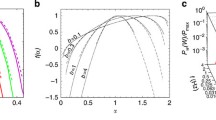Abstract
We determine the asymptotic forms of work distributions at arbitrary times T, in a class of driven stochastic systems using a theory developed by Nickelsen and Engel (EN theory) [D. Nickelsen and A. Engel, Eur. Phys. J. B 82, 207 (2011)], which is based on the contraction principle of large deviation theory. In this paper, we extend the theory, previously applied in the context of deterministically driven systems, to a model in which the driving is stochastic. The models we study are described by overdamped Langevin equations and the work distributions in path integral form, are characterised by having quadratic augmented actions. We first illustrate EN theory, for a deterministically driven system – the breathing parabola model, and show that within its framework, the Crooks fluctuation theorem manifests itself as a reflection symmetry property of a certain characteristic polynomial, which also determines the exact moment-generating-function at arbitrary times. We then extend our analysis to a stochastically driven system, studied in references [S. Sabhapandit, EPL 89, 60003 (2010); A. Pal, S. Sabhapandit, Phys. Rev. E 87, 022138 (2013); G. Verley, C. Van den Broeck, M. Esposito, New J. Phys. 16, 095001 (2014)], for both equilibrium and non-equilibrium steady state initial distributions. In both cases we obtain new analytic solutions for the asymptotic forms of (dissipated) work distributions at arbitrary T. For dissipated work in the steady state, we compare the large T asymptotic behaviour of our solution to the functional form obtained in reference [New J. Phys. 16, 095001 (2014)]. In all cases, special emphasis is placed on the computation of the pre-exponential factor and the results show excellent agreement with numerical simulations. Our solutions are exact in the low noise (β → ∞) limit.
Article PDF
Similar content being viewed by others
Change history
29 March 2018
Reference [20] is corrected to: V. Holubec, D. Lips, A. Ryabov, P. Chvosta, P. Maass, Eur. Phys. J. B 88, 340 (2015)
Additionally, the reference given in the abstract [S. Sabhapandit, EPL 89, 60003 (2010)] is corrected to: [J.R. Gomez-Solano, L. Bellon, A. Petrosyan, S. Ciliberto, EPL 89, 60003 (2010)]
References
U. Seifert, Rep. Progr. Phys. 75, 126001 (2012)
G.E. Crooks, Phys. Rev. E 61, 2361 (2000)
C. Jarzynski, Phys. Rev. Lett. 78, 2690 (1997)
C. Jarzynski, Phys. Rev. E 56, 5018 (1997)
R. van Zon, E.G.D. Cohen, Phys. Rev. E 67, 046102 (2003)
R. van Zon, E.G.D. Cohen, Phys. Rev. E 69, 056121 (2004)
R. van Zon, E.G.D. Cohen, Phys. Rev. Lett. 91, 110601 (2003)
R. van Zon, S. Ciliberto, E.G.D. Cohen, Phys. Rev. Lett. 92, 130601 (2004)
D. Nickelsen, A. Engel, Eur. Phys. J. B 82, 207 (2011)
T. Speck, J. Phys. A: Math. Theor. 44, 305001 (2011)
C. Jarzynski, Phys. Rev. E 56, 5018 (1997)
D.M. Carberry, J.C. Reid, G.M. Wang, E.M. Sevick, D.J. Searles, D.J. Evans, Phys. Rev. Lett. 92, 140601 (2004)
C. Kwon, J.D. Noh, H. Park, Phys. Rev. E 88, 062102 (2013)
A. Ryabov, M. Dierl, P. Chvosta, M. Einax, P. Maass, J. Phys. A: Math. Theor. 46, 075002 (2013)
B. Saha, S. Mukherji, Eur. Phys. J. B 88, 146 (2015)
H. Touchette, Phys. Rep. 478, 1 (2009)
A. Pal, S. Sabhapandit, Phys. Rev. E 87, 022138 (2013)
S. Sabhapandit, EPL 96, 20005 (2011)
L.F. Shampine, M.W. Reichelt, J. Kierzenka, Solving Boundary Value Problems for Ordinary Differential Equations in MATLAB with bvp4c, Available at www.mathworks.com/bvp_tutorial
V. Holubec, M. Dierl, M. Einax, P. Maass, P. Chvosta, A. Ryabov, Phys. Scr. 2015, 014024 (2015)
D. Nickelsen, A. Engel, Phys. Scr. 86, 058503 (2012)
G. Verley, C. Van den Broeck, M. Esposito, New J. Phys. 16, 095001 (2014)
P. Pietzonka, F. Ritort, U. Seifert, Phys. Rev. E 96, 012101 (2017)
R.P. Feynman, A.R. Hibbs, Quantum mechanics and path integrals. International series in pure and applied physics (McGraw-Hill, Maidenhead, Berkshire, 1965)
L.S. Schulman, Techniques and applications of path integration (Wiley, New York, 1996)
K. Kirsten, A.J. McKane, Ann. Phys. 308, 502 (2003)
G.M. Falco, A.A. Fedorenko, I.A. Gruzberg, J. Phys. A: Math. Theor. 50, 485201 (2017)
A. Engel, Phys. Rev. E 80, 021120 (2009)
K. Sekimoto, J. Phys. Soc. Jpn. 66, 1234 (1997)
K. Sekimoto, Progr. Theor. Phys. Suppl. 130, 17 (1998)
S. Machlup, L. Onsager, Phys. Rev. 91, 1512 (1953)
L. Onsager, S. Machlup, Phys. Rev. 91, 1505 (1953)
R. Courant, D. Hilbert, in Methods of mathematical physics (Wiley, New York, 1953), Vol. 1
K. Kirsten, P. Loya, Am. J. Phys. 76, 60 (2008)
C. Kwon, J.D. Noh, H. Park, Phys. Rev. E 83, 061145 (2011)
J.R. Gomez-Solano, L. Bellon, A. Petrosyan, S. Ciliberto, EPL 89, 60003 (2010)
V.Y. Chernyak, M. Chertkov, C. Jarzynski, J. Stat. Mech.: Theory Exp. 2006, P08001 (2006)
M. Chaichian, A. Demichev, Path integrals in physics: volume I: Stochastic processes and quantum mechanics (Institute of Physics Publishing, Bristol and Philadelphia, 2001)
M. Doi, J. Phys. A: Math. Gen. 9, 1465 (1976)
M. Doi, J. Phys. A: Math. Gen. 9, 1479 (1976)
L. Peliti, J. Phys. 46, 1469 (1985)
Author information
Authors and Affiliations
Corresponding author
Rights and permissions
Open Access This article is distributed under the terms of the Creative Commons Attribution 4.0 International License (https://creativecommons.org/licenses/by/4.0), which permits use, duplication, adaptation, distribution, and reproduction in any medium or format, as long as you give appropriate credit to the original author(s) and the source, provide a link to the Creative Commons license, and indicate if changes were made.
About this article
Cite this article
Manikandan, S.K., Krishnamurthy, S. Asymptotics of work distributions in a stochastically driven system. Eur. Phys. J. B 90, 258 (2017). https://doi.org/10.1140/epjb/e2017-80432-9
Received:
Revised:
Published:
DOI: https://doi.org/10.1140/epjb/e2017-80432-9



